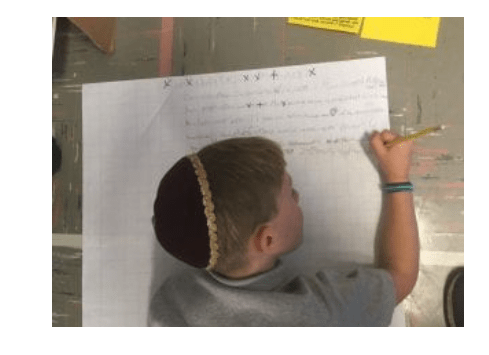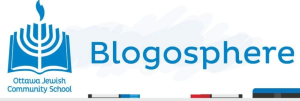For the Love of STEM
Falling in Love with STEM in First Grade
In first grade, something magical happens when you introduce young learners to STEM—Science, Technology, Engineering, and Math. Curiosity sparks. Eyes widen. Tiny hands get busy building, creating, and solving problems. STEM is more than just an acronym—it’s a powerful way to get children engaged and excited about learning.
This year, our class dove into STEM with hearts wide open and minds ready to explore. Two incredible projects helped us see just how meaningful and fun learning can be when we blend STEM with storytelling, creativity, and collaboration.
🦌 Creating Wildlife Crossings: Innovation Inspired by Nature
Our Innovation Day projects were inspired by the thought-provoking book Make Way for Animals! A World of Wildlife Crossings by Meeg Pincus. A special thank you to our amazing librarian, Brigitte, for recommending this book as the perfect springboard for our STEM adventure.

After reading about wildlife crossings from around the world and how they help animals travel safely across busy roads, our class began to wonder—could we build our own? The students were bursting with excitement and ready to take on the challenge. Each child selected an animal to support and began designing a crossing that would allow their chosen species to cross safely.
The Challenge:
Design and build a wildlife crossing that spans at least 30 cm and supports a weight of 100 grams.
With cardboard, glue, tape, and a whole lot of determination, the children partnered up and got to work. They brainstormed, sketched, built, tested, and redesigned. Our classroom was buzzing with collaboration, creativity, and that wonderful kind of mess that means learning is alive and well. True to our North Star, We Learn Better Together, students helped one another troubleshoot and problem-solve as they worked toward a common goal.
Innovation Day was a huge success! Families were invited to see the finished projects, and the children beamed with pride as they shared their process and final designs. The joy, confidence, and critical thinking on display were incredible to witness.
🐷 STEM Meets Storytelling: The Three Little Pigs Reimagined
After the break, our first graders tackled a new challenge: building windproof houses for the Three Little Pigs—inspired by the book Making a Windproof House for the Three Little Pigs by Sue Gagliardi.
This time, students used engineering principles to design and build houses that could withstand the huffs and puffs of the Big Bad Wolf—simulated by a blow dryer! The room filled with laughter and suspense as we tested each structure. Would the house stand strong or be blown away?
Then, we added a creative twist. Students wrote brand-new endings to the story. What happens when the wolf can’t blow the houses down? The blend of STEM and Language Arts brought out some of the most imaginative, resilient, and joyful work we’ve seen all year.
🗺️ Building, Mapping, and Collaborating in Grade One
In Social Studies, our STEM energy carried over into a community-building project. Students partnered up to create 2D maps and then worked together to build a 3D community. Each student chose a community helper to research and designed the corresponding building—from hospitals to fire stations to post offices. They even created a map key to symbolize their growing community.
Here’s just a glimpse at our mini-city:
| Community Helper | Community Building | |
| Vet | Animal Hospital | |
| Vet | Animal Shelter | |
| Postmaster | Post Office | |
| Farmer | Barn & Farm | |
| Chef & Restaurant Owner | Restaurant | |
| Teacher & Principal | School & Playground | |
| Policeman | Police Station | |
| Firefighter | Fire Station | |
| ER Doctor | Hospital |
This project was all about collaboration—a key first-grade skill. Students practiced patience, problem-solving, and communication as they worked in teams and shared responsibilities. The pride on their faces as they presented their work to the class said it all.
💡 STEM Brings Learning to Life
STEM challenges bring so many learning goals together: critical thinking, creativity, resilience, collaboration, and joy. Whether building animal crossings or windproof houses, our first graders are discovering that learning is hands-on, meaningful, and full of wonder.
As a teacher, I’ve loved every moment of watching them grow—not just in skills, but in confidence. These STEM projects are as fun and rewarding for me as they are for the kids. I can’t wait to see where their curiosity takes them next!
Stay tuned—there’s always a new adventure just around the corner in 1A.
Reading and Writing in First Grade
Making Every Minute Count: Teaching Grade One in a Trilingual School
Teaching two Grade One general studies classes in a trilingual school is both a privilege and a puzzle. With exactly 680 minutes a week per class, I’m responsible for teaching Language Arts, Math, Science, and Social Studies—all while supporting children who are navigating not just one, but three languages.
The question I return to again and again is: how do we get first graders to become readers and writers with so little instructional time?
The answer lies in focus, targeted practice, and the power of research-backed programs.
Assessment and Early Intervention: A Smart Start
To ensure every child gets exactly what they need, our school uses Amplify assessments, based on the DIBELS framework, to guide our reading instruction. These assessments measure:
![]()
We conduct three major benchmark assessments each year—in September, January, and June. These provide clear snapshots of student progress and help us track growth over time.
Between these benchmarks, teachers can also use progress monitoring tools up to three times per term. This is especially helpful for students who fall below the benchmark, allowing us to keep a close eye on their progress and adjust instruction in real time.
As early as September, students who need extra support begin working with our reading interventionist. These children receive targeted instruction three times a week, focused on foundational reading skills. This early, proactive approach ensures that every child in the class receives optimal instruction, whether through whole-group teaching, small-group differentiation, or focused intervention.
It’s a carefully balanced system: high expectations, strong routines, real-time data, and targeted support—so that all our students can build the strong foundation they need to become confident readers.
The Science of Reading as Our Foundation
At our school, we’ve made a commitment to teaching reading based on the Science of Reading, which means our instruction is explicit, systematic, and grounded in how the brain learns to read. We use three main programs to guide our practice:
- UFLI Foundations for phonics instruction
- Boost Reading for targeted, differentiated practice
- Amplify assessments to monitor student progress and drive data-informed instruction
UFLI provides the backbone of our phonics instruction. Each week, I carve out daily blocks of structured literacy time that include phonemic awareness, phonics, high-frequency word instruction, decodable reading, and application in writing. These are short, focused lessons—no fluff, just the essentials, layered day by day.
Boost Reading steps in to personalize the journey. It’s our “silent partner,” giving students just-right practice that builds confidence and fluency. Meanwhile, Amplify gives me the data I need to differentiate with purpose—I know which students need more time with CVC words, who is ready for blends, and who needs targeted support with oral language and comprehension.
Making Time Work: Cross-Curricular Learning
680 minutes sounds like a lot—until you start breaking it down. That’s why every minute matters. I use center-based learning and rotating stations to allow for small-group guided reading and independent literacy practice.
But the biggest secret? Cross-curricular projects.
We bring literacy into math, science, and social studies. Students write observations in science journals, create labeled diagrams, solve word problems by writing number stories, and build social studies booklets that tie into our reading goals. These projects not only maximize instructional time but also spark deep engagement and real-world connections.
Reading Happens at Home Too
One of the most important parts of our literacy program is daily reading homework in all three languages—English, Hebrew, and French. This routine begins in the first few weeks of school, and children quickly settle into it. Every night, they’re practicing what they’ve learned, reinforcing decoding skills, and developing fluency.
In English, students are sent home with decodable books that directly align with their UFLI lessons. This daily practice is essential—it bridges school learning with home reinforcement, allowing students to apply their phonics knowledge in real reading situations.
But what about our fluent readers? Those students who have already mastered the basic decoding skills are encouraged to choose chapter books for homework. These might be early reader series or slightly more advanced novels, depending on the child’s level and interest. This keeps reading meaningful and appropriately challenging, while fostering independence and reading stamina.
The results? They’re amazing.
Children who came into Grade One as beginning readers are suddenly reading with confidence across multiple languages. It’s a powerful reminder that practice, practice, practice—at school and at home—really does pay off.
Writing: Building Stamina and Confidence
Our writing instruction begins the moment students start putting sounds to paper. Because handwriting is introduced in Kindergarten with Handwriting Without Tears, I can focus in Grade One on helping students connect letter formation with sound-symbol knowledge and meaning.
We write every single day—even if it’s only for 10 or 15 minutes. At the start of the year, we focus on simple sentence structure using decodable words. As the year progresses, we introduce shared writing, modeled writing, and scaffolded independent writing. Writing is integrated across subjects, too: a math story problem becomes a writing prompt; a science observation becomes a labeled diagram or descriptive sentence.
Writing: Expression, Creativity, and Purpose
Writing is woven into our daily rhythm, starting with daily journal time. This sacred space allows children to express their thoughts and feelings, while putting all their UFLI phonics lessons into action. It’s where spelling patterns, sentence structure, and personal voice come together naturally.
We also plan strategic story-writing sessions, where students dive into the full writing process—from brainstorming and drafting to revising and sharing. These sessions help them develop as creative storytellers and build stamina, confidence, and pride in their work.
As the year progresses, we gradually introduce genre-based writing instruction to build a wide foundation of skills:
- A few months into the school year, students take on research-based animal projects. They read, gather facts, and organize their findings into short, informative pieces—often with labeled diagrams and nonfiction text features.
- In the middle of the year, procedural writing is introduced through hands-on STEM and science experiments, teaching students how to explain a process step-by-step using sequencing words and clear instructions.
- In the final semester, we guide students through narrative writing, letter writing, and opinion writing, giving them new ways to communicate, reflect, and persuade. This gradual progression keeps writing fresh, meaningful, and developmentally aligned.
Making Time Work: Prioritizing What Matters
680 minutes sounds like a lot—until you start breaking it down. That’s why every minute matters. I use project-based learning and stations to rotate small groups through targeted instruction. While I teach a guided reading group, another group may be working on a writing task, while another is engaged in Boost Reading or word work.
Integration is key. Science and Social Studies are taught through language—we read informational texts, we write about what we observe, we create mini-books, and we use vocabulary in context. These subjects enrich our literacy time rather than compete with it.
Final Thoughts
Teaching in a trilingual school is a gift. Our students are developing their identities across languages, cultures, and disciplines. And while time is tight, structure and intention make it possible to do deep, meaningful work. The Science of Reading has given us the roadmap. Programs like UFLI, Boost, and Amplify have given us the tools. But it’s the daily routines, the careful planning, and the belief in our students’ potential that turn those 680 minutes into a launchpad for lifelong literacy.
Reading Matters
Making Reading Fun Throughout the Year
As a Language Arts teacher, one of my most cherished responsibilities is instilling a love of reading in my students. Over the years, I have discovered numerous ways to make reading a fun and magical experience, ensuring that students not only improve their literacy skills but also develop a lifelong passion for books. Here are some of the strategies I use throughout the year to keep the excitement for reading alive in my classroom
Reading Aloud
No matter the grade level, reading aloud is a cornerstone of my teaching practice. It is a powerful way to model fluent reading, expose students to new vocabulary, and immerse them in the rhythm and cadence of the written word. Each year, I participate in The Global Read Aloud, an initiative that connects students worldwide through shared stories. My students eagerly look forward to our Zoom calls or Padlet discussions with peers from different countries. This global exchange of ideas and interpretations enriches their reading experience and broadens their perspectives.
One particularly heartwarming moment came from my current grade 8 students, who fondly remembered our Global Read Aloud activity from Grade 4. They were so excited to see the sequel to a beloved novel at our school book fair that they pooled their money to buy it for me. Their pride and joy in presenting the book to me was a testament to the lasting impact of our shared reading experiences.
Reading Buddies
Another cherished activity is our Reading Buddies program, which pairs older students with younger ones. This initiative not only fosters a sense of community and responsibility but also allows older students to act as reading role models. The interactions between the buddies are heartwarming to witness, as they share stories, laughter, and the joy of reading together.
Book in a Bag Projects
To engage students in reading and sharing their books, we undertake Book in a Bag projects. Each student selects a book, reads it, and then places objects related to the story in a bag. These objects serve as props during their book presentations to the class, sparking curiosity and discussion among their peers. This hands-on approach makes the storytelling process interactive and memorable.
Reading in Grade One
Grade one is a pivotal time in a child’s reading journey, and focusing on reading has always been a passion of mine. This year, using the Amplify assessment program has transformed how I monitor and support each student’s reading journey. From the very beginning, Amplify’s benchmark and progress assessments have been invaluable tools, allowing me to keep a close eye on every child’s strengths and challenges.
Amplify’s system places students into appropriate reading levels and offers various activities, lessons, and reading passages tailored to enhance specific skills. This customization is essential, ensuring each child receives the right support and challenge. The progress graphs that Amplify generates are particularly impressive. They visually depict a child’s advancement in various reading areas, providing a clear and comprehensive picture of their growth.
During parent-teacher interviews, these graphs become powerful artifacts. Sharing them with parents offers concrete evidence of their child’s progress, making the reading development journey transparent and collaborative. Parents appreciate seeing the data, as it highlights how much their child has improved and where they still need to grow. It turns abstract progress into something tangible and understandable.
The online Amplify system is remarkably user-friendly. It meticulously tracks each mistake a student makes during assessments throughout the year. This level of detail allows me to identify specific patterns and areas where support is needed, so I can tailor my instruction accordingly. I’m continually amazed at the volume and quality of activities and reading materials Amplify provides. There are many reading passages to print and use, ensuring my lessons remain fresh and engaging.
I hope the lower grades will continue using this assessment program next year. I am eager to do a deep dive into the customized reading goals for each student, as I believe this will further enhance our ability to support every young reader effectively. Amplify has not only streamlined the assessment process but also enriched our reading curriculum, making a significant difference in how we teach and our students learn.
Amplify assessment is also a powerful tool for older students who get resource support.
Adding a Touch of Magic
Always on the lookout for innovative ways to make reading magical, I introduced Novel Effect to my classroom this year. This app adds soundscapes to stories, creating an immersive reading experience. I was thrilled to be asked to serve as an ambassador for Novel Effect, which provided me with a free year’s subscription and access to an online community of educators. This community inspired us to participate in the March Magic book bracket, a global event where students read and voted on their favorite books. The excitement and engagement this activity generated were truly phenomenal. * I have the free app for the upcoming school year. I will be happy to visit classes to share the Novel Effect magic.
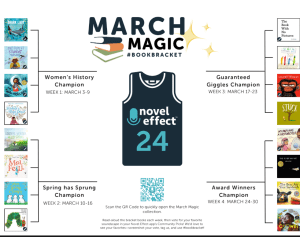

Brigitte’s Summer Reading Challenge
To maintain students’ interest and engagement in reading over the summer, our school has implemented Brigitte’s Summer Reading Challenge. This program is especially important for students who struggle with reading, as it helps prevent the “summer slide” and keeps their skills sharp. The challenge encourages students to read a certain number of books over the summer, with incentives such as prizes for those who meet their goals.
Incorporating fun and motivating elements, the summer reading challenge makes reading a part of students’ daily routines even when school is out. Whether it’s through reading logs, book reviews, or creative projects, the challenge offers various ways for students to engage with their books and share their experiences. Prizes, ranging from small trinkets to larger rewards like gift cards or a special recognition ceremony, add an extra layer of motivation.

The Joy of Reading
Making reading fun throughout the year is a journey filled with creativity, connection, and joy. Whether through reading aloud, global collaborations, creative projects, innovative apps, or advanced assessment tools like Amplify, my goal is to create an environment where students look forward to reading and see it as an adventure. The smiles on their faces, the excitement in their voices, and the pride in their achievements are the greatest rewards for me as a teacher. Here’s to many more years of joyful reading adventures.
Reading with Puppies
A dream prototype for OJCS!
Just imagine if we had such a program at OJCS. I believe our reading scores would improve tremendously. We should have tried this before all the renovations.
Learning from my colleagues at parent conferences
I have always loved getting a chance to talk with parents about their children. We’ve been doing conferences with our teaching team. It’s always nice to have good conversations about the children.
This year, it struck me how impressed and happy the parents were with their children’s ability to read in all three languages and speak all three languages. Ada and Efi told parents how students use complex sentences in Hebrew and French. I realized that I have been too easy on the students in journal writing. I expect a sentence or two each day, and that is about it. I have to encourage and help some students think of ideas. A few parents admitted the students don’t enjoy journal writing. I had no idea how much the children were doing with their other teachers. Efi encouraged me to raise the bar and make it more challenging for the classes.

As I sat in the conferences with parents and talked with my partners during the breaks, I started to reflect and change up some of my teaching plans for writing. I thought about previous years in Grades 3 & 4. My students wrote more on topics they were interested in. This week, we read a story about a dream house, and I let the students draw their dream house and describe it in writing. The students were excited and wrote more than they had all year.


As a class, we even talked about writing on topics of interest to us. The students admitted it was much more fun, and yes, I am already thinking of Grade One passion projects. I am loving how the students are so interested in each other’s work displayed in class.

During the conferences, we discussed the goals the children chose earlier in the year. We discussed adding some academic goals into the mix this term. I will meet with my students to incorporate specific reading, writing, and math goals. I will let you know how that goes.
It is easy to get caught up in your teaching and curriculum and not have enough time in the day in the schedule. We need to stop and learn all the things our teaching teams do. It might even connect with your curriculum. We also need to appreciate how hard it is to work and learn in three languages each day.
#We Learn Better Together
Documenting Learning For Silvia
In the Fall of 2018, our school launched class blogs. Each grade shared class happenings and updates on the class blog. Our school also launched a consultancy with Silvia Tolisano at the same time. Her book Documenting the Learning, co-written with Janet Hale, is an extensive guide on how to make learning visible, meaningful, and shareable through blogfolios. A cohort of teachers spent time with Silvia learning how to capture and document student learning through their blogs.

This cohort quickly became blogging experts and shared their learning with the rest of the teachers on staff. In January, I was fortunate to welcome Silvia and the cohort of teachers into my classroom. I had the opportunity to watch how they documented the learning happening in my Grade 3 class.
The amount of information and insight gained into my students’ learning in just one lesson was amazing.
Take a look at the Blog Posts Below
In July 2019, Silvia Tolisano was a presenter at the conference, and my colleague Lianna Krantzberg and I attended her workshop on Digital portfolios and Documenting learning. She suggested that if teachers want their students to use blogs to document their learning. The teachers should document their learning through a blog. This statement got me thinking. My colleague, Lianna started a professional blog at the airport on the way home from the conference. A week later, my colleague Josh Ray convinced me to start my blog. It has been instrumental in reflecting on my learning and growth as a teacher. Silvia was our positive mentor, cheering us on from the sidelines. She answered all our questions and got us to share our learning through our blogs.

I have launched student blogfolios with my classes over the last three years. The students enjoyed documenting their learning. Silvia was right! I have seen firsthand how students step up their game and write more, care more, and take more pride in their work using blogfolios. They love the idea that more people will read their work rather than just their teacher. I get it, as I feel the same way about my professional blog. I choose my words carefully and put more care into my work.
I know the students take ownership of their work. Blogfolios are the places students can ponder questions, record reflections, and talk about what they learned during the process. Of course, it will also be the spot to showcase final projects, writing, and activities.
This platform lets teachers personalize learning and enrich students. The beauty of writing posts, making videos, and taking pictures, is that students will be in charge of how far to take their learning. It will help us hit some of our school’s north stars.

Students learn more when they think and reflect on their work. I read so much these days about digital portfolios for students in high school and how crucial it is for learning. The fact that our school launches blogfolios at the elementary level is terrific. We teach our students how to take ownership of their learning at a young age which will serve them well in their academic careers. I have seen firsthand how motivated and engaged students are in posting work for the world to see. The extra effort goes into every assignment. The Grade 4-8 students have blogfolios, and this year Grades 2 &3 will launch blogfolios too. I am excited about the positive effect this will have on our students.
Silvia passed away in March 2021. I am sad to have lost such a positive teacher and mentor. Fortunately, I have her book and blog posts as my guide. We will be documenting our learning at OJCS the way Silvia taught us.

Documenting Learning
Each year at my school, the OJCS teachers choose a professional growth project. This project should be in an area where teachers would like to grow and improve their craft. I decided to focus on teaching my students how to document their learning as my growth project. I have launched student blogfolios during the last couple of years. I helped my students populate their blogfolios with projects, speeches, and Innovation Day projects.
This year I wanted to teach my students to take greater ownership of their learning, and what better way to do it than by documenting the process as it was happening. The head of the school, Dr. Jon Mitzmacher, suggested I focus my project on a specific teaching unit in the Spring. I met with our teaching and learning coordinator, Melissa Thompson, to brainstorm possible ideas for such a unit. We settled on a Social Studies unit, and I started to get excited about planning the cross-curricular lessons. Teaching at a trilingual school has time challenges. I have roughly eleven and a half hours a week with each class to teach: English, Science, Math, and Social Studies. The trick is to get the students excited and engaged with a cross-curricular approach. As I walked back to my class, I had the whole unit planned in my head.

I planned a unit on Early Settlers in Upper Canada in the 1780-1850 time period. I decided to teach my classes how to document their learning as we went through another unit. Remote and Hyflex learning put a hold on this in early 2022. The classes started the unit at the beginning of May. The students filled out the KWHL chart before we began. They knew a little about the period and had many questions. We watched films from the NFB(National Film Board of Canada) and read stories about Early settlers. Ms. Brigitte, our school librarian, brought a bin of books to help us begin the research process.
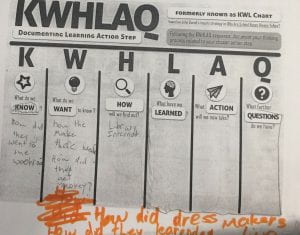

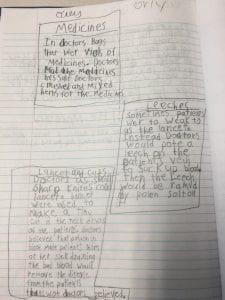
Each class became a village, and the students chose an occupation for their villagers. The children became more interested; the research began. Students searched 1800-era marriage records for the Ottawa area to find villagers’ names. As a class, we discussed different options for presenting our research. We settled on writing a blog post about our villager, writing a letter to a relative describing life in Canada, and writing two Instagram posts. We also thought it would be fun to map the village complete with coordinates. The area and perimeter of the buildings in the village had the students calculating and having fun.


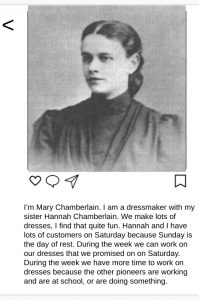
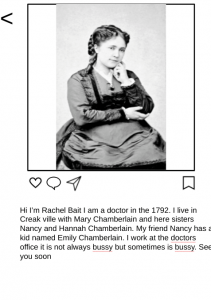
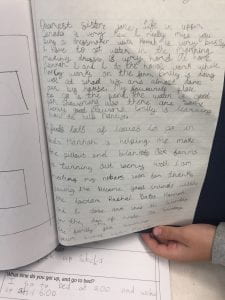
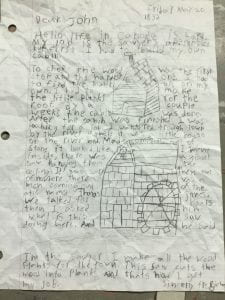
The classes designed 3D models and started constructing the buildings found in the village. Some of my students were less than enthusiastic about this part of the project. They had constructed buildings for an Ideal city project we did earlier in the year. I decided to talk with the classes and see if students would like the choice of how to construct the buildings. I brought up the idea of using Minecraft to make the buildings. Student voice and choice in a project will bring another level of engagement to a project. As a teacher, this type of engagement in work is fun to observe. Students worked on their Minecraft buildings over the weekend, and it wasn’t even part of a homework assignment.
Projects like this have the students self-directed and busy as they work on the different assignments. The next step in this cross-curricular unit is to take it to the top level of Bloom’s Taxonomy; create. Students have the choice to create a newspaper, a podcast, or a news report about life in the early settler village. There is excitement in the air, and the ideas are flowing as the classes brainstorm the best way to complete the project. Stay tuned for the final reveal.
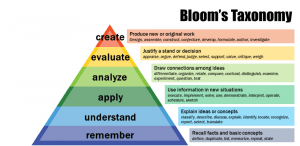
How did the documenting as learning go? The students took lots of pictures and videos. Now I have to get everything onto the blogfolios. At the grade three-level, the teacher is the one to populate the blogfolios. It is more difficult to upload documents, pictures, and videos on iPads. The two classes share 15 iPads for English and Hebrew, and it remains a challenge to have the time to update the blogs.

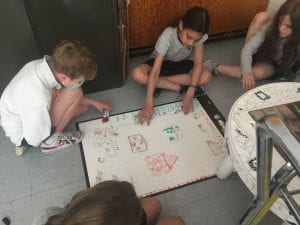

Students reflected on the learning that took place in class discussions. The students will annotate the pictures and reflect once the work is uploaded. I feel strongly about documenting and reflecting on learning. It helps the students be more mindful of the learning process. I liken this to the Teacher professional growth process. The teacher can learn and grow if they want to do the work. It is the same with the children. Teaching students to document their learning would flow right into student-led conferences. It would be a game-changer for learning at this school. Students need to start the documentation process in their younger years. Our North Stars are within reach.
#We own our own learning #There is a floor, but no ceiling
Because of a Teacher
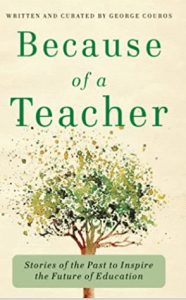
This past September, I had the opportunity to read the book Because of a Teacher through a Facebook group I joined in the Fall. The group was geared toward Health Habits and Mindfulness for educators. I needed to make some changes for the better. Distance and Hyflex learning kept students challenged and growing; it took a toll on teachers and their work-life balance.
Teachers who never had a chance to sit down in the regular classroom found themselves sitting at a computer in the remote classroom. Weekends found teachers sitting at the computer uploading schedules, links, and work. The truth is that since March 2020, I got into the habit of spending my Sundays at the dining room table, working on my weekly schedule, and uploading it to my class blog.
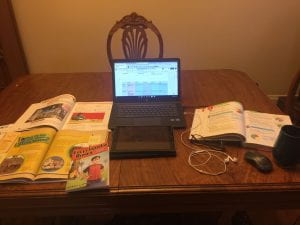
George and Paige Couros ran the six-week program on Facebook. The book Because of a Teacher guided our weeks in the group. It is full of heartfelt stories about the impact teachers make in the lives of their students. The stories remind teachers how valued they are and the importance of their work with children.
The first week Paige asked us to share what we were looking forward to that week. I shared that I was looking forward to an upcoming event at work. Teaching is my passion; my work-life balance starts to blur. I knew I needed to plan fun activities to look forward to throughout the week. I started taking fall hikes in Gatineau Park, went apple picking, and enjoyed lunch on outdoor patios with my family. Lucky for me my older children were happy to spend time with me on the weekends.
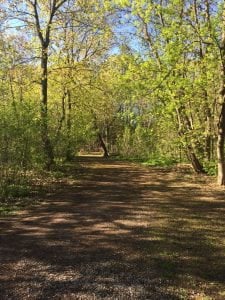
Each week we read a few chapters of the book Because of a teacher and reflected on questions that related to our personal and professional lives. Reading these stories made me grateful that I chose to teach as my profession. It was the perfect book to read.

George Couros started a Mindset Monday podcast to get us to reflect and start our week on the right foot. I listened to the Mindset Mondays podcast while I drank my coffee in the morning. Each podcast had me reflecting on life in education, and I loved it.
Developing healthy habits was a primary focus of the Facebook group, yet I couldn’t seem to start an exercise routine. George shared his healthy habits. It was then that I thought maybe I could do it too. I decided to exercise in the morning. A colleague at school told me that she would text me in the mornings to help keep me accountable. It was just what I needed. The neat thing is, Lianna Krantzberg is a former grade two student who is now my colleague at school. Each morning we would text each other and cheer each other on to the workout. It felt great to exercise before school and accomplish something before getting to school. Healthy habits started to take form, and work-life balance equalized.
Teacher parent conferences led to my own memorable Because of a Teacher moments. My teaching team met with each set of parents and had meaningful conversations about our students. The parents were appreciative and shared how much their children loved coming to school. As a teacher, I can tell you how much this means to us. Our compelling why for teaching is always for the children. Moments like this fill hearts and keep teachers teaching.
I have to say that since the beginning of the pandemic, parent-teacher conferences have become so special. I seem to have had the nicest parents in my classes. Perhaps both parents and teachers have been more authentic with each other? Parents have been so appreciative and have shared how much their children love school. We have even heard that some students wished they could come to school on weekends.
A quote from a parent
” One of the silver linings of the COVID experience is that through distance learning, you each entered your students’ homes and brought the school community closer to become an even tighter knit family. That was no small feat, and it was with your dedication and care for your students such a warm, supportive online experience was created. Thanks again!”
Notes and pictures from students make us smile too!
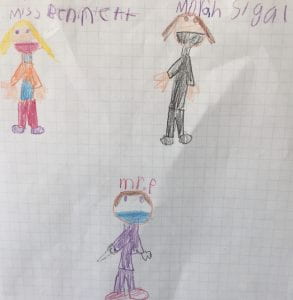
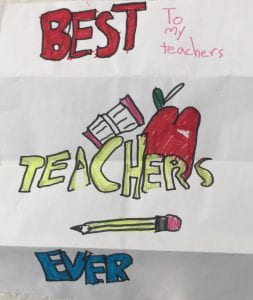
My school, the OJCS, is full of incredible teachers. We have been through so much in the past two years. We have encouraged, supported, and laughed with each other. I know there are Because of a Teacher moments happening all the time. I think our school and schools everywhere should celebrate their own # Because of a Teacher moments. It would be the perfect follow up to Teacher Appreciation week.
Because of a Teacher is filled with so many beautiful stories. Reading this book made me appreciate being a teacher and filled my bucket. I looked back on my own # Because of a Teacher moments in my career. This book led me to the Facebook group, which led me to develop healthier habits. Most importantly, this book reminded me that I impact the lives of my students.
I encourage teachers everywhere to read Because of a Teacher.
The Global Impactor Program
In December 2020, I discovered that I would become part of a Global Impactor Cohort. Dr. Marialice Curran sent me an email to tell me that she would be putting me into this cohort. It was the day before Winter Break started, and I was so excited to hear this news.

The cohort headed by Dr. Marialice Curran consisted of mentors and mentees: and the soul mission was to connect with others globally and show students how to use tech for good. The meetings started on the first Friday in January. It was interesting to meet with other educators and learn about the Global Impactor Program. We discussed the five pillars of digital citizenship and how to inspire students to become good digital citizens by incorporating them into our classes. There were educators from Scotland, Kenya, Kuwait, India, and the United States. The first meeting flew by, and I found myself looking forward to the next meeting.


We were all given free subscriptions to the Belouga platform. Belouga.org is a web-based educational platform that connects classrooms around the world. The platform has so many informative videos to enhance classroom teaching. Founder and CEO Evin Schwartz showed us how best to use Belouga in our classes and connect.
We met each Friday and took part in learning something new. Each meeting had us thinking about something else. There were enthralling guest speakers who taught us the importance of mental health, play in the classroom, learning through e-games, coding, and the value of Minecraft in the classroom. The best part of each session was how we all learned alongside each other. It also helped me get through a strict lockdown in my city and distance learning in my school. I was so happy to connect with fabulous educators around the world.
We met with our mentors and talked about potential projects for our classes. Since my class was launching their blogfolios, Marialice suggested making a Public Service Announcement with my students. We shared our projects with the larger group. Marialice created a DM Twitter group for the Global Impactor Cohort. This DM group allowed members to send links to upcoming talks, events, or podcasts. I found myself enjoying learning about coding with students and listening to informative podcasts in the evenings and on weekends.
A favourite session was learning about the value of play in the classroom, even the third-grade classroom. Jess Amato showed us how to alleviate stress by playing quick and simple games with students. Even a 5-10 minute game could be beneficial and build community. After this session, I brought Madlibs into my virtual classroom, and the student loved it. Playing this game for a few minutes a day added laughter to our class. I secretly enjoyed how my students were reviewed nouns, verbs, adjectives, and adverbs.
Eric Kussen of the Same Here foundation talked with us about the importance of mental health. It was a talk that stayed with me the rest of the year. Good mental health is vital at the best of times. It became even more crucial during the second period of remote learning for my students in April; the lockdown was so strict in Ottawa, Ontario, that parks were off-limits for children. I jumped at the chance to take part in the #Same Here Mental Health Awareness Month on the Belouga Platform in May. My class participated in a talk with Dr. Marialice Curran and students in New York. We talked about things we did for our mental health to cope with lockdowns and remote learning.

Another connection I made was with a mentor Dene Gainey, an educator from Florida. He had written a play, Diversity: It’s Not Just About You, It’s About Us: Together We’re Better. I decided that my classes would read it for our reading sessions. The students loved getting their parts and becoming the different characters in the play. They loved coming to virtual class and doing read-throughs of the play. The best part was when Dene and I got our classes together over Google Meet. The students introduced themselves and the characters they played. It was nice to see the students discuss the parts they had. Dene kindly answered all my students’ questions about being a playwright and writing. He inspired my students that a couple of them started to write a play.
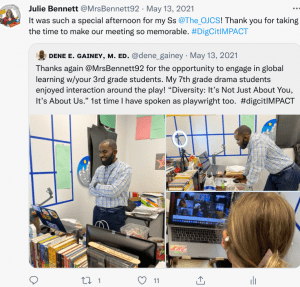

My Global Impactor project was to make a public service announcement on making good comments on blogs. My class had launched blogfolios (digital portfolios/blogs), and this project was the perfect way for my students to help others learn how to make comments. I thought a trilingual public service announcement would help my students practice the three languages they study at school. The class had lots of fun writing and recording it.
I was so happy to be part of this Global Impactor cohort. The global connection and the inspiration of teaching students to use tech for good were just what I needed in a year of Covid and remote learning. Special thanks to Marialice for being such a positive leader and mentor. You have inspired us all to make a global impact!
Teaching Grade 3 in 2020-2021
As term 3 begins I am taking a moment to reflect on the year in Grade Three so far. Time sure does fly when you are having fun. I cannot believe that I have already spent six and a half months with my classes and this is the first blog post I have written about being their teacher. The truth is I love teaching both my classes and I am doing all that I can to make sure they have a great year.
I have learned the importance of authentic tasks for students and teachers alike. Returning to school in September with covid restrictions in place was a challenge. I wondered how to get my students excited about learning as they sat in rows and worked independently. Oh yes, and not be worried about Covid either!
Science was the answer! I switched my teaching units around and started the year off studying soil. I could get the children outside, get them moving, and give them a chance to get fresh air. Little did I know that it would be the start of such a terrific year. The whole class got right into learning about soil, and well, we found a worm.
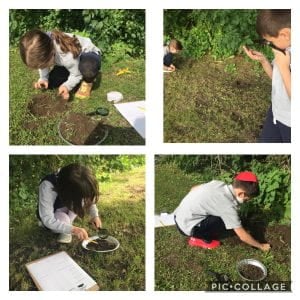
The learning then took a turn, and we started reading and researching about worms. We couldn’t believe how much they helped soil. We collected worms and started a worm compost. I was brave enough to hold some worms and not pass out, and the children loved it. We then dove into growing plants from kidney beans, and the children were excited. My students who found it challenging to sit still during class were fully engaged and loving learning.
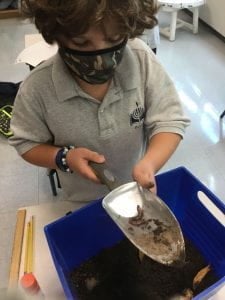

Students who hadn’t loved school in the early grades suddenly wanted to learn and didn’t want to miss a class. Authentic tasks are the answer! I presented global math task challenges for students to complete. I connected with a fellow educator in Tennessee, and we got our classes together for a Mystery Number game. The students loved it, and they were completely engaged. The students also worked on Global Math Task challenges that Heidi Samuelson posts each week.
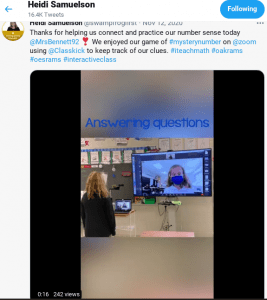

We had zoom calls with students in Tel Aviv, and we talked and learned from each other. We took part in a global Livestream event at the DigCit Summit: the students took turns talking about digital citizenship. My students also took a research project they worked on and shared the information with a class in Taiwan to learn about Ontario cities. All these tasks and projects have been authentic and have enriched the teaching and learning in my class.
I had learned that relationship is the key to getting students excited about learning. It was an important lesson that I took away from distance learning in the spring. I had started the year off trying to build those relationships as quickly as I could. The truth of the matter is I thought we would be in school for a few weeks, and I had to get to know my students fast. I am grateful that I spent 15 weeks in the class with my students before we had a month of distance learning.
I have been working hard to teach my students about digital citizenship over this year. Launching student blogfolios have been the next logical step in learning about being a good digital citizen online. It is crucial to teach children how to use the internet safely and learn about digital footprints at an early age, especially in this world of YouTubers and Tik Tok videos.

My students need to learn the same lessons about posting on the internet. I have watched how engaged and motivated the students are when they work on a blog post or connect with another class. I am excited to see how they will put greater effort into their work and pay special attention to detail. I believe the quality of the written work will improve and the students will work harder to edit before they publish a post. The students are reading classmates’ posts and making comments. It is so much fun to see the children connecting in this way. Perhaps some grandparents will even read a post or two and comment.
I also believe that the blogs will give my quieter students a chance to share their voices and shine. Blogs will also be a perfect place for students to own and enrich their learning. Students will reflect on their learning, document it, and make their thinking visible.
STEM challenges are inspiring students to be innovators and problem-solvers. We are working on a global Public Service Announcement with the Digital Citizenship Institute to teach people how to make good comments on blogs. We are writing a song about peace for the global World Peace Song Project. The Global Act Aloud will have us showing off our acting skills. We also working on a kindness initiative.
In this year like no other, my main goals have been to get the children excited about learning, connecting globally. It is safe to say that we are having fun and learning so much in Grade 3. I am excited to see what the rest of the school year has in store for us.















